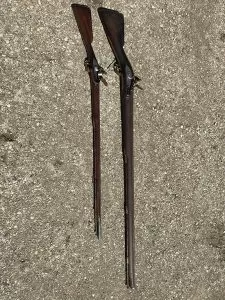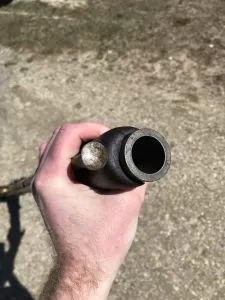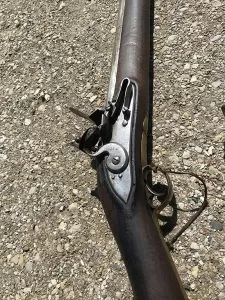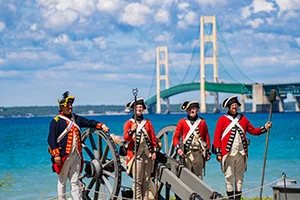 If you’ve visited Colonial Michilimackinac, there’s a good chance that you’ve seen the interpreters demonstrating a cannon or musket during our daily programs. There is another 18th century weapon that gets fired occasionally, and it’s an interesting cross between a cannon and a musket. Let’s take a look at our wall gun.
If you’ve visited Colonial Michilimackinac, there’s a good chance that you’ve seen the interpreters demonstrating a cannon or musket during our daily programs. There is another 18th century weapon that gets fired occasionally, and it’s an interesting cross between a cannon and a musket. Let’s take a look at our wall gun.

A wall gun is essentially just a supersized musket. As the name implies, wall guns were intended to be fired resting on a wall or the railing of a ship, and many original weapons were fitted with a yoke or swivel similar to an oarlock to facilitate easy mounting. Such a rest was necessary given the weight and size of the weapon. Wall pieces were typically .91 caliber, had four and a half foot-long barrel (although some were as long as six feet), measured over six feet long in total, and weighed between 35 and 40 pounds. Constructed in only limited quantities, primarily in the 1740s and again in the 1770s, wall pieces were intended to function as artillery pieces in situations were even the smallest and lightest of cannons were impractical. Although unwieldy, a wall gun could be positioned and fired by just one soldier. Firing a 2¼-ounce ball, they could apparently hit targets 500 to 600 yards away, and were ideal for use during sieges, when they could be moved around to fire on enemy engineers and sappers. During the American Revolution, Captain William Congreve of the Royal Regiment of Artillery, a noted artillery innovator, suggested employing wall guns as a secondary weapon alongside field guns. Under Congreve’s plan, wall guns mounted on two-wheeled carts accompanied artillery detachments and were deployed alongside the cannons. A vertical wooden mantlet, or shield, attached to the cart protected the two soldiers serving the guns. Despite their size, wall guns remained a muzzle-loading flintlock weapon, and as such were loaded and fired in much the same way as a normal sized musket.

Although the British military only produced wall guns in limited numbers, two of them found their way to Michilimackinac in the 1770s. Classified as ordnance along with the garrison’s cannons and mortar, the walls guns were apparently intended to serve in detached positions outside the main palisade wall. In 1768, Captain-lieutenant Frederick Spiesmacher of the 60th Regiment requested permission to build a blockhouse on a sandy hill outside the fort. He wanted a blockhouse large enough for six men and two wall guns. Spiesmacher probably never built the blockhouse, as a decade later Lieutenant Governor Patrick Sinclair ordered a blockhouse built overlook and command hollow ground behind a sand hill which the troops could not reduce,” which would also flank the trader’s houses in the suburbs outside the palisade. When the blockhouse was finished in early 1780, Sinclair noted that it contained positions for three artillery pieces, but the wall guns could also have been used there. The guns were moved to Mackinac Island with the rest of the fort by 1781, but disappear from the Fort Mackinac ordnance returns soon after. Whether they were sent away or merely no longer recorded with the larger artillery pieces is unclear.
 Today, our reproduction wall gun is occasionally fired for demonstrations, sometimes taking the place of the cannon or mortar for an artillery firing. An original wall gun is also on display in the underground powder magazine and Firearms on the Frontier exhibit. Be sure to see the original piece next time you visit Colonial Michilimackinac, and you might be lucky enough to see the reproduction fired on the parade ground!
Today, our reproduction wall gun is occasionally fired for demonstrations, sometimes taking the place of the cannon or mortar for an artillery firing. An original wall gun is also on display in the underground powder magazine and Firearms on the Frontier exhibit. Be sure to see the original piece next time you visit Colonial Michilimackinac, and you might be lucky enough to see the reproduction fired on the parade ground!









